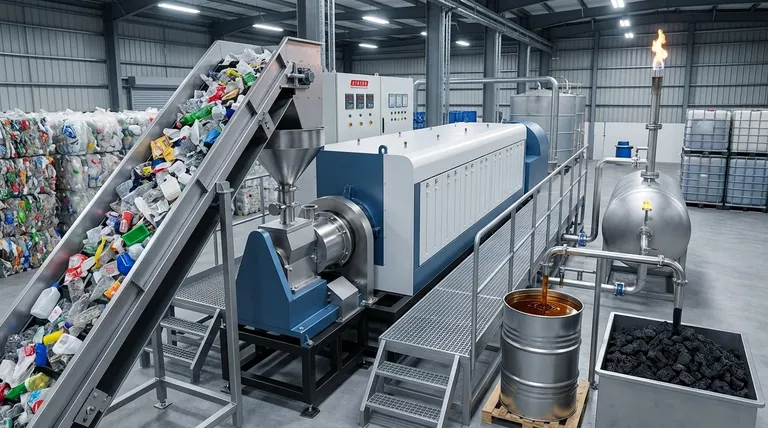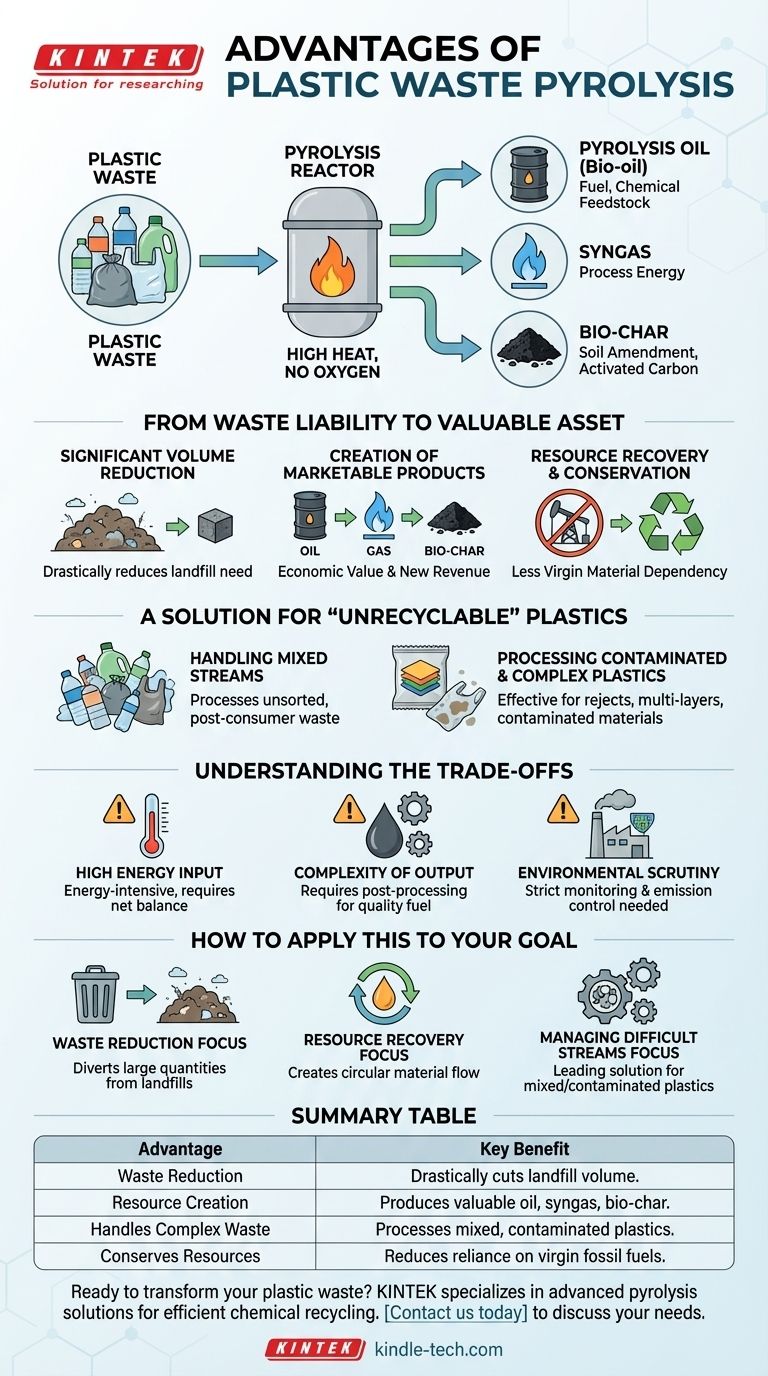At its core, pyrolysis is a powerful method for chemical recycling. It converts plastic waste, which would otherwise end up in a landfill, into valuable new resources like fuel and chemical feedstocks. This is achieved by heating the plastics to very high temperatures in the absence of oxygen, which breaks down the complex polymer chains into simpler, reusable materials.
The fundamental advantage of pyrolysis is its ability to transform low-value, mixed, and often non-recyclable plastic waste from an environmental liability into a source of valuable energy products and raw materials, effectively closing the loop in a circular economy.

From Waste Liability to Valuable Asset
The primary function of pyrolysis is to unlock the value embedded within plastic waste. It treats discarded plastics not as trash, but as a resource waiting to be recovered.
Significant Waste Volume Reduction
Pyrolysis drastically reduces the physical volume of plastic waste. By breaking down the solid material, it provides a powerful alternative to landfilling, which addresses the immediate and pressing problem of limited landfill capacity.
Creation of Marketable Products
The process converts solid waste into several valuable outputs. These products have direct economic applications and can create new revenue streams.
- Pyrolysis Oil (Bio-oil): This liquid product is a mix of aromatic and aliphatic hydrocarbons. It can be used directly as an industrial fuel or refined further to serve as a feedstock for producing new chemicals and plastics.
- Syngas: This mixture of combustible gases can be used on-site to power the pyrolysis process itself, making the operation more energy-efficient and self-sustaining.
- Bio-char: This solid carbon-rich residue has multiple uses. It can serve as a soil amendment to improve agricultural land or be processed into activated carbon for filtration and purification applications.
Resource Recovery and Conservation
By creating fuel and chemical feedstocks from waste, pyrolysis reduces our dependence on virgin raw materials. This directly lessens the environmental impact associated with extracting and processing fossil fuels.
A Solution for "Unrecyclable" Plastics
One of the most significant advantages of pyrolysis is its ability to handle plastic streams that traditional mechanical recycling cannot.
Handling Mixed Plastic Streams
Mechanical recycling often requires clean, well-sorted streams of a single type of plastic. Pyrolysis is far more versatile, capable of processing mixed post-consumer plastics and segregated plastics from municipal solid waste without extensive pre-sorting.
Processing Contaminated and Complex Plastics
Pyrolysis is particularly effective for materials that are considered "rejects" of mechanical recycling. This includes complex multi-layer packaging (like food pouches) and plastics contaminated with different polymers (like PET/PVC mixes), which would otherwise be destined for the landfill.
Understanding the Trade-offs
While the advantages are compelling, a clear-eyed assessment requires acknowledging the operational realities and challenges.
High Energy Input
The process requires heating materials to very high temperatures. This is an energy-intensive operation, and the overall environmental benefit depends on the net energy balance—ensuring the energy produced is greater than the energy consumed.
Complexity of the Output
Pyrolysis oil is not a direct replacement for crude oil. It often requires significant post-processing, upgrading, and refining before it can be used as a high-quality fuel or chemical feedstock, which adds technical complexity and cost.
Environmental Scrutiny
Like any industrial thermal process, pyrolysis plants must be equipped with sophisticated monitoring and control systems. Managing emissions and ensuring the safe handling of all outputs is critical to being a truly "eco-friendly" solution and meeting regulatory standards.
How to Apply This to Your Goal
Your strategy for using pyrolysis should align with your primary objective for waste management.
- If your primary focus is waste volume reduction: Pyrolysis is an extremely effective technology for diverting large quantities of plastic from landfills.
- If your primary focus is resource and energy recovery: The process excels at converting low-value plastic waste into fuel and chemical feedstocks, creating a circular flow of materials.
- If your primary focus is managing difficult waste streams: Pyrolysis is one of the leading solutions for mixed, contaminated, or multi-layer plastics that cannot be mechanically recycled.
Ultimately, pyrolysis provides a robust technological pathway to redefine plastic waste as a valuable resource for the future.
Summary Table:
| Advantage | Key Benefit |
|---|---|
| Waste Reduction | Drastically cuts landfill volume from plastic waste. |
| Resource Creation | Produces valuable pyrolysis oil, syngas, and bio-char. |
| Handles Complex Waste | Processes mixed, contaminated, and multi-layer plastics. |
| Conserves Resources | Reduces reliance on virgin fossil fuels for new products. |
Ready to transform your plastic waste into a valuable resource? KINTEK specializes in advanced pyrolysis equipment and consumables for efficient chemical recycling. Our solutions help laboratories and waste management facilities convert plastic waste into fuel and feedstocks, supporting a sustainable circular economy. Contact us today to discuss how our technology can meet your specific needs!
Visual Guide

Related Products
- Electric Rotary Kiln Small Rotary Furnace Biomass Pyrolysis Plant
- 1700℃ Laboratory Quartz Tube Furnace with Alumina Tube Tubular Furnace
- 1200℃ Split Tube Furnace with Quartz Tube Laboratory Tubular Furnace
- Vacuum Sealed Continuous Working Rotary Tube Furnace Rotating Tube Furnace
- Graphite Vacuum Furnace High Thermal Conductivity Film Graphitization Furnace
People Also Ask
- What are the components of biomass pyrolysis? A Complete Guide to the System, Products, and Process
- What is a disadvantage of biomass energy? The Hidden Environmental and Economic Costs
- What are the advantages of pyrolysis technology? Turn Waste into Profit and Reduce Emissions
- What are the reactions involved in pyrolysis of biomass? Unlock the Chemistry for Tailored Bio-Products
- What are the products of pyrolysis of biomass? Unlock Bio-Char, Bio-Oil, and Syngas



















